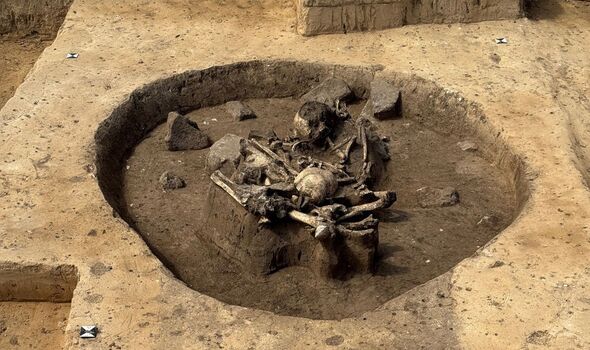Lifestyle
Archaeologists Uncover 5,000-Year-Old Ritual Pits in Germany

Construction of the high-voltage electric powerline project, known as the SuedOstLink, in Germany has led to remarkable archaeological discoveries. During the ongoing work to transport electricity from northern Germany to Bavaria, archaeologists have unearthed a dozen sacrificial pits dating back 5,000 years near Gerstewitz in Saxony-Anhalt. These findings provide significant insights into ancient ritual practices of the region.
The pits, associated with the Salzmünde Culture (circa 3400 to 3050 BC), reveal a community deeply influenced by their environment and challenges. Known for their unique burial customs, this culture often placed their dead in crouched positions beneath layers of pottery shards and remnants of burnt homes. Researchers discovered twelve deep, circular pits, each measuring between seven to ten feet wide and up to eight feet deep, enclosed within a ditch system.
Within these pits, archaeologists found charred remnants of buildings, complete ceramic vessels that were likely used as sacrificial offerings, and bones from both animals and humans. Among the most striking discoveries was the remains of a dog, positioned anatomically and showing signs of fire damage, found alongside an intact human skull. This contrast suggests a complex burial practice that might have involved temporary display or storage of remains prior to final interment.
The research team stated, “This suggests that the pits remained open during extended ceremonies, or that the dog bones were kept in another place for a prolonged period of time.” One converted oven pit revealed the burial of two individuals who likely decomposed elsewhere before being laid to rest, indicating a deliberate and multi-phase ceremonial process.
The findings reflect the harsh conditions faced by the Salzmünde Culture. Archaeological artefacts and climatological data indicate that Central Europe experienced cooler and more erratic weather patterns during the late 4th millennium BC. Such changes would have significantly impacted agricultural communities, including the Salzmünde. Additionally, the Bernburg Culture, another Neolithic group, began expanding into the region from the north around this time, potentially adding to the stress on local resources.
The researchers highlighted that “the rituals, by which people were apparently seeking the support of their ancestors, can be understood in the context of this period of crisis.”
Evidence of the Salzmünde Culture was first documented in 1921, and archaeologists have since identified multiple sites linked to this ancient group. As the SuedOstLink project continues, further discoveries may emerge, shedding more light on the lives and rituals of these early communities.
-

 Entertainment2 months ago
Entertainment2 months agoIconic 90s TV Show House Hits Market for £1.1 Million
-

 Lifestyle4 months ago
Lifestyle4 months agoMilk Bank Urges Mothers to Donate for Premature Babies’ Health
-

 Sports3 months ago
Sports3 months agoAlessia Russo Signs Long-Term Deal with Arsenal Ahead of WSL Season
-

 Lifestyle4 months ago
Lifestyle4 months agoShoppers Flock to Discounted Neck Pillow on Amazon for Travel Comfort
-

 Politics4 months ago
Politics4 months agoMuseums Body Critiques EHRC Proposals on Gender Facilities
-

 Business4 months ago
Business4 months agoTrump Visits Europe: Business, Politics, or Leisure?
-

 Lifestyle4 months ago
Lifestyle4 months agoJapanese Teen Sorato Shimizu Breaks U18 100m Record in 10 Seconds
-

 Politics4 months ago
Politics4 months agoCouple Shares Inspiring Love Story Defying Height Stereotypes
-

 World4 months ago
World4 months agoAnglian Water Raises Concerns Over Proposed AI Data Centre
-

 Sports4 months ago
Sports4 months agoBournemouth Dominates Everton with 3-0 Victory in Premier League Summer Series
-

 World4 months ago
World4 months agoWreckage of Missing Russian Passenger Plane Discovered in Flames
-

 Lifestyle4 months ago
Lifestyle4 months agoShoppers Rave About Roman’s £42 Midi Dress, Calling It ‘Elegant’









